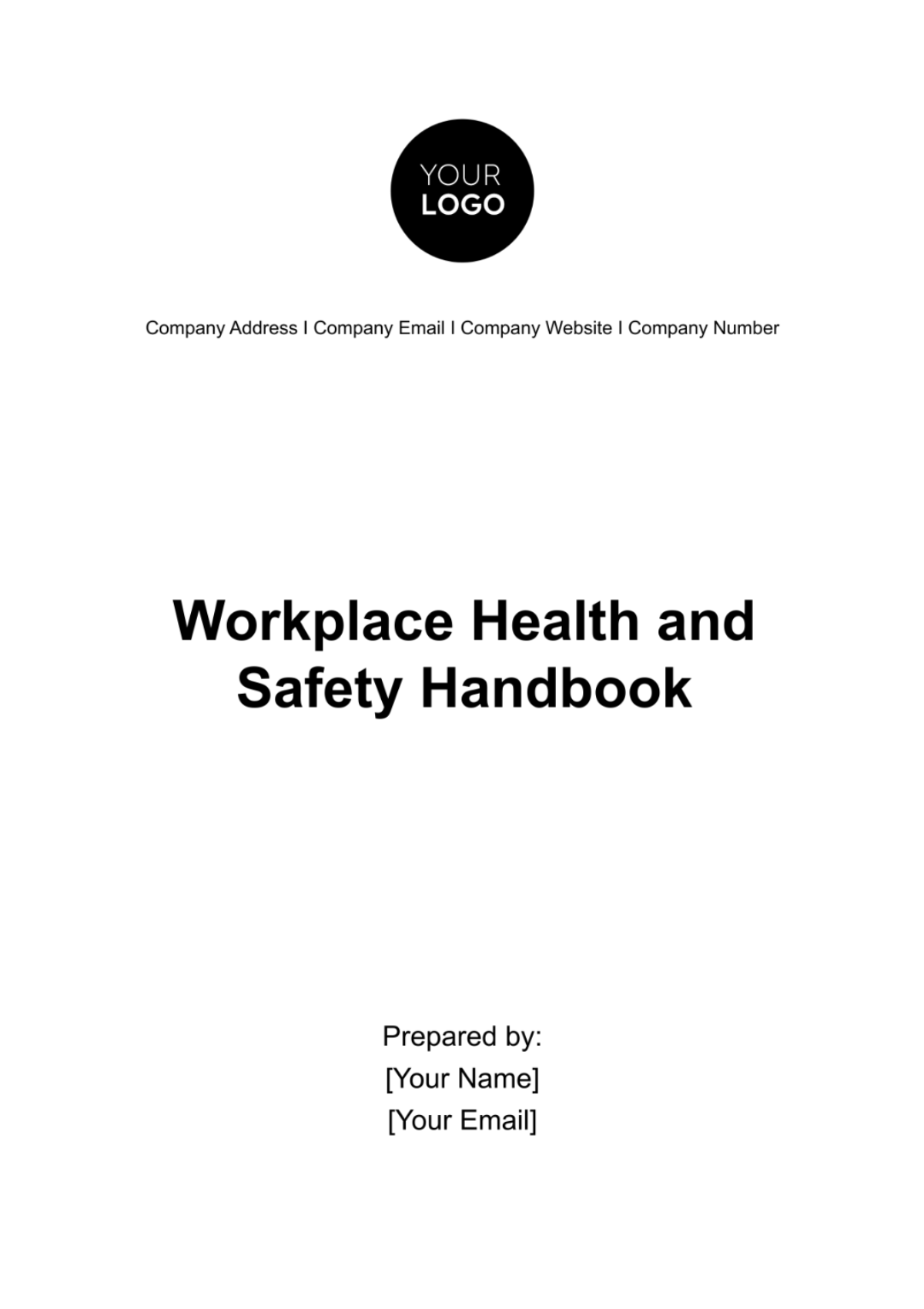Free Workplace Health and Safety Handbook

I. Introduction
This handbook embodies our commitment to creating a secure and health-conscious work environment. It is a guide, outlining our procedures, expectations, and shared responsibilities in maintaining workplace safety. Every employee's awareness and active participation are vital in fostering a culture where safety is paramount.
II. Company Health and Safety Policy
Our Health and Safety Policy at [Your Company Name] is more than just compliance; it is a commitment to the well-being of our team. This section outlines our dedication to creating a safe work environment, highlighting our goals for incident prevention and the overall health and well-being of our employees.
A. Mission Statement: Our mission is to ensure every employee returns home safely each day. We strive to exceed legal safety standards, creating a workplace where health and safety are ingrained in our operations.
B. Objectives: To minimize risks, reduce workplace accidents, and promote health and wellness among our staff.
C. Commitment to Continuous Improvement: Regularly reviewing our practices, we pledge to adapt and evolve our safety protocols, ensuring they are effective and aligned with the latest industry standards.
III. Roles and Responsibilities
In this section, we detail the specific responsibilities of management, employees, and the Health and Safety Committee. Understanding and fulfilling these roles are crucial for the effectiveness of our safety program.
A. Management Responsibilities
Ensuring legal compliance, providing safety training, and maintaining a safe working environment.
Ensuring Legal Compliance | Understanding Regulations |
Policy Development | |
Compliance Audits | |
Providing Safety Training | Development of Training Programs |
Regular Training Sessions | |
Training Documentation | |
Maintaining a Safe Working Environment | Workplace Assessments: |
Resource Allocation | |
Culture of Safety |
B. Employee Responsibilities
Following safety protocols, reporting hazards, and participating in safety training and drills.
Following Safety Protocols | Adherence to Rules |
Use of Personal Protective Equipment (PPE) | |
Participation in Safety Drills | |
Reporting Hazards | Identification of Hazards |
Prompt Reporting | |
Suggestions for Improvement | |
Participating in Safety Training and Drills | Engagement in Training |
Knowledge Application | |
Feedback on Training |
C. Health and Safety Committee
Overseeing the implementation of safety policies, conducting workplace inspections, and addressing employee concerns regarding safety.
Overseeing the Implementation of Safety Policies | Policy Review and Updates |
Communication of Policies | |
Monitoring Compliance | |
Conducting Workplace Inspections | Scheduled Inspections |
Inspection Reports | |
Follow-Up on Actions | |
Addressing Employee Concerns Regarding Safety | Open Communication Channels |
Issue Resolution | |
Feedback Loop |
IV. Risk Assessment and Management
Risk assessment and management are key to preemptively identifying and mitigating hazards in the workplace. This proactive approach involves a three-step process of hazard identification, risk evaluation, and implementation of control measures.
A. Hazard Identification
Hazard Identification is the first step in the risk assessment process, where potential sources of harm or adverse health effects on individuals in the workplace are recognized. This process involves a systematic examination of the work environment to identify tools, procedures, substances, and conditions that may cause injury, illness, or damage.
B. Risk Evaluation
Once hazards are identified, Risk Evaluation involves determining the likelihood and severity of any injury or health issue resulting from these hazards. This step assesses the potential impact of each hazard and the extent of the risk it poses, helping prioritize which risks need immediate attention.
C. Control Strategies
Control Strategies are measures implemented to eliminate or reduce the identified risks to an acceptable level. This step involves selecting appropriate ways to manage each risk, which can include eliminating the hazard, substituting it with a less dangerous option, or implementing safety measures:
V. Health and Safety Procedures
This section outlines the general safety rules and procedures, including emergency response protocols and incident reporting mechanisms. Adherence to these procedures is essential for preventing accidents and ensuring a rapid and coordinated response in case of emergencies.
A. Safety Rules
These are specific guidelines established to prevent accidents and injuries in the workplace. They are based on risk assessments and are tailored to address the unique hazards of a particular work environment. These rules are mandatory and must be followed by all employees to ensure their safety and the safety of others.
B. Emergency Procedures
These are predefined plans detailing the actions employees should take in case of a workplace emergency. These emergencies could range from fires and medical crises to natural disasters. The procedures aim to minimize harm to employees and property and ensure a quick, organized response to emergencies.
C. Incident Reporting
Incident reporting is the process through which employees report workplace accidents, near misses, and other safety issues. This process is critical for documenting incidents, identifying causes, and implementing measures to prevent future occurrences.
VI. Specific Safety Protocols
Addressing specific risks associated with equipment, hazardous materials, and workplace ergonomics, this section provides detailed protocols.
A. Equipment Safety
These protocols focus on preventing accidents and injuries associated with the use of machinery and tools in the workplace. These protocols involve regular maintenance checks, proper use of equipment, and training for employees.
Key Aspects:
Maintenance and Inspection: Regularly scheduled checks to ensure equipment is functioning correctly and safely. This includes checking for wear and tear, ensuring safety guards are in place, and verifying control systems are operational.
Training and Operation: Employees must receive training on the correct operation of machinery, including start-up and shut-down procedures, emergency stops, and handling malfunctions.
Safety Gear and Precautions: Ensuring employees use the required personal protective equipment (PPE) and adhere to safety precautions while operating equipment, like keeping clear of moving parts and not bypassing safety features.
B. Hazardous Material Management
Hazardous Material Management involves protocols for safely handling, storing and disposing of substances that could pose a risk to health or the environment. These materials could include chemicals, biohazards, flammable materials, or toxic substances.
Key Aspects:
Safe Handling and Usage: Procedures outlining how to safely handle hazardous materials, including the use of appropriate PPE, ventilation systems, and spill containment methods.
Storage and Labeling: Guidelines for storing hazardous materials safely, including segregation of incompatible substances, secure storage facilities, and clear labeling indicating the nature of the hazards.
Spill Response and Disposal: Emergency response procedures for spills or leaks, including containment, clean-up, and reporting. Additionally, protocols for the safe disposal of hazardous materials to prevent environmental contamination.
C. Ergonomic Practices
These are about designing workplace environments and job tasks to fit the physical capabilities of employees, thereby reducing the risk of strain injuries and musculoskeletal disorders. This involves assessing the layout of workstations, the design of tools and equipment, and the organization of work tasks.
Key Aspects:
Workstation Design: Adjusting workstations to suit the employee, including chair height, monitor position, and keyboard placement to minimize strain.
Tool and Equipment Ergonomics: Using ergonomically designed tools that reduce stress on the body, such as keyboards with wrist supports or tools with padded handles.
Work Practice Adjustments: Implementing practices such as regular breaks, job rotation, and stretching exercises to reduce the risk of repetitive strain injuries and improve overall comfort and efficiency.
VII. Health and Safety Training
Training is a critical component of our safety program, ensuring that all employees are equipped with the knowledge and skills to work safely. This section outlines the training requirements, schedules, and record-keeping.
A. Mandatory Training Programs
Comprehensive training covering general safety awareness and specific job-related hazards.
General Workplace Safety and Health Awareness: This training program is designed to provide a comprehensive overview of basic workplace safety and health principles. It covers a wide range of topics including the importance of safety in the workplace, understanding and identifying potential hazards, the proper use of safety equipment, and basic first aid. The goal is to ensure that all employees, regardless of their role or level, have a foundational understanding of how to maintain a safe working environment. This training typically includes interactive sessions, practical demonstrations, and assessments to ensure understanding and retention of key safety concepts.
Emergency Response and Evacuation Training: It focuses on preparing employees for handling emergency situations such as fires, earthquakes, medical emergencies, and other unforeseen events. This program teaches employees the proper evacuation procedures, how to use emergency equipment (like fire extinguishers), and the roles and responsibilities during an emergency. It also covers the importance of emergency exit routes, assembly points, and the protocols for accounting for all employees during an emergency. Regular drills and simulations are a crucial part of this training to ensure employees are prepared to respond swiftly and effectively in real-life scenarios.
Hazard-Specific Safety Training: It is tailored to address the unique risks associated with specific jobs or work environments within the organization. For instance, employees working in a chemical laboratory would receive training on handling hazardous substances, while those in a manufacturing setting might focus on machinery safety. This program includes detailed instructions on safe operating procedures, the use of personal protective equipment, and steps to take in the event of a hazard-related incident.
B. Specialized Training
Additional training for employees working in high-risk areas or with specific safety-critical tasks.
Advanced First Aid and Medical Emergency Response: This training is especially important in workplaces where there is a higher risk of serious injuries or health incidents. Participants learn advanced techniques in cardiopulmonary resuscitation (CPR), use of automated external defibrillators (AEDs), handling of severe wounds, managing shock, and dealing with specific medical emergencies like allergic reactions or heart attacks.
Handling and Management of Hazardous Materials: This specialized training is crucial for employees who handle, store, or dispose of hazardous materials. The program covers topics such as the proper identification of hazardous substances, understanding Material Safety Data Sheets (MSDS), safe handling and storage procedures, spill control and cleanup techniques, and the use of appropriate personal protective equipment (PPE).
Machinery and Equipment Operation Safety: This program focuses on the safe operation of specific machinery, including start-up and shut-down procedures, routine maintenance checks, dealing with equipment malfunctions, and emergency stop procedures. Participants are taught to recognize potential hazards associated with equipment operation and learn preventive measures to avoid accidents.
C. Training Records
Documentation procedures for tracking employee training, vital for compliance and ongoing safety management.
VIII. Monitoring and Continuous Improvement
Monitoring the effectiveness of our safety practices and making continual improvements is essential for maintaining a dynamic and effective health and safety program. This section describes our approach.
A. Safety Audits
Regular audits to assess compliance and the effectiveness of safety measures, with findings leading to action plans for improvement.
B. Feedback and Review
Encouraging employee feedback and regularly reviewing and updating safety procedures based on new information and changing conditions.
C. Continuous Improvement
Commitment to a cycle of ongoing evaluation and enhancement of safety practices.
IX. Acknowledgment
I, [Name], acknowledge that I have received, read, and understand the contents of the Workplace Health and Safety Handbook of [Your Company Name].

[Name]
[Job Title]
[MM-DD-YYYY]
- 100% Customizable, free editor
- Access 1 Million+ Templates, photo’s & graphics
- Download or share as a template
- Click and replace photos, graphics, text, backgrounds
- Resize, crop, AI write & more
- Access advanced editor
Introducing the Workplace Health and Safety Handbook Template from Template.net. Crafted for seamless usability, it's fully editable and customizable to suit your organizational needs. With the intuitive Ai Editor Tool, create comprehensive safety manuals effortlessly. Elevate workplace safety standards with this essential resource.





























